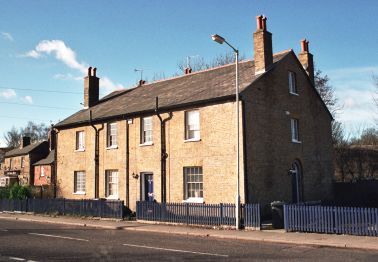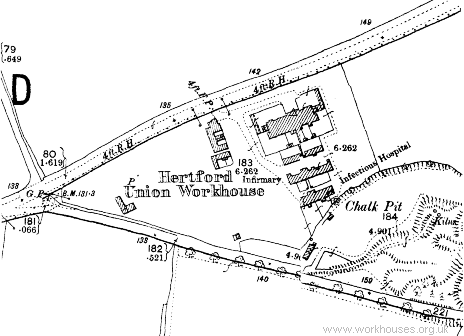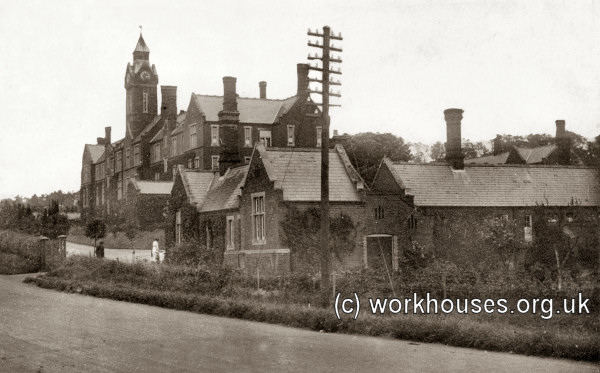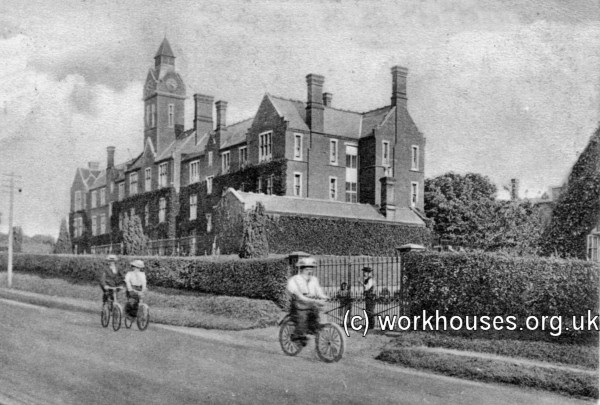Hertford, Hertfordshire
Up to 1834
In February 1725, An Account of Several Workhouses... recorded that:
Four years later, a further account reported:
THEIR Weekly Bill of Fare is as follows.
| Breakfast | Dinner | Supper | |
| Sunday | Bread & Cheese | Meat | Broth |
| Monday | Broth | Pease-Porridge | Bread and Cheese |
| Tuesday | Bread & Cheese | Hasty-Pudding | Bread and Cheese |
| Wednesday | Bread & Cheese | Meat | Broth |
| Thursday | Broth | Frumety | Bread and Cheese |
| Friday | Bread & Cheese | Ox-Head | Broth |
| Saturday | Broth | Hasty-Pudding | Bread and Cheese |
N. B.. None are Stinted as to Quantity, but all eat till they are satisfy'd.
A parliamentary report of 1777 recorded parish workhouses in operation in Hertford—All Saints (for up to 30 inmates), Hertford—St Andrew (50), Hertford—St John (24), Little Amwell (4), Bengeo (15), Hertinfordbury (30), Tewin (20) and Walkern (20).
A house on Horns Mill Road in Hertford, dating from around 1820, served as the poorhouse for the Liberty of Brickendon.

Former Brickendon workhouse, 2003.
© Peter Higginbotham.
After 1834
Hertford Poor Law Union was formed on 18th June 1835. Its operation was overseen by an elected Board of Guardians, 21 in number, representing its 18 constituent parishes as listed below (figures in brackets indicate numbers of Guardians if more than one):
County of Hertford: Little Amwell, Aston, Bayford, Bengeo, Bennington, Little Berkhamstead [Little Berkhampstead], Brantfield [Bramfield], Brickendon, Datchworth, Hertford All Saints (2), Hertford St Andrew's (2), Hertford St John's (2), Hertingfordbury, Sacombe, Stapleton, Tewin, Walkern, Watton [at Stone]
The population falling within the Union at the 1831 census had been 12,155 — with parishes ranging in size from Bramfield (population 204) to Hertford St Andrew's (1,826). The average annual poor-rate expenditure for the period 1832-35 had been £8,202 or 13s.6d. per head of the population.
Initially, the new Hertford Union adopted an existing parish workhouse and in 1836, the Poor Law Commissioners authorised an expenditure of £350 for its adaptation.
A new Union workhouse was erected in 1867-9 on Ware Road to the east of Hertford. The site, on high ground, was known locally as Gallows Hill.

Hertford workhouse site, 1898.

Hertford Union workhouse from the north-west, c.1905.
© Peter Higginbotham.
The buildings, for 250 inmates, were designed by Frederick Peck who was also the architect of Union workhouses at East Grinstead and Chatham. It cost £12,000 and was constructed of red brick by local builder Henry Norris. The three-storey Jacobean-style building had mullioned windows, gables, and a central clock tower.

Hertford Union workhouse from the north-west, c.1910.
© Peter Higginbotham.
In 1919, the Hertford workhouse was taken over by the Hertfordshire County Committee for Mental Defectives and the existing inmates were dispersed to the St Albans and Ware workhouses. The Hertford Poor Law Union was itself dissolved in 1924. The workhouse building later became Kingsmead Special School. The site has now been redeveloped for residential use.
Staff
Inmates
Records
Note: many repositories impose a closure period of up to 100 years for records identifying individuals. Before travelling a long distance, always check that the records you want to consult will be available.
- Hertfordshire Archives and Local Studies, County Hall, Pegs Lane, Hertford SG13 8DE. Holdings include Guardians' minute books (1835-9, 1858-62, 1887-1916); Births (1847-1919); Deaths (1847-1919); Admissions and discharges (1873-6, 1887-1916); etc.
Bibliography
- Gutchen RM, Truwert E, and Peters G (1984) Down and Out in Hertfordshire — A Symposium on the Old and New Poor Law (Hertfordshire Publications)
- An Account of Several Work-houses for Employing and Maintaining the Poor. Anon, 1725.
Links
- None.
Unless otherwise indicated, this page () is copyright Peter Higginbotham. Contents may not be reproduced without permission.


